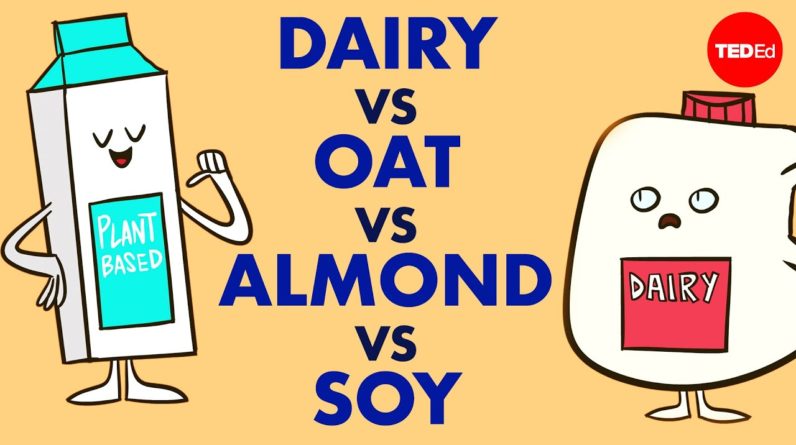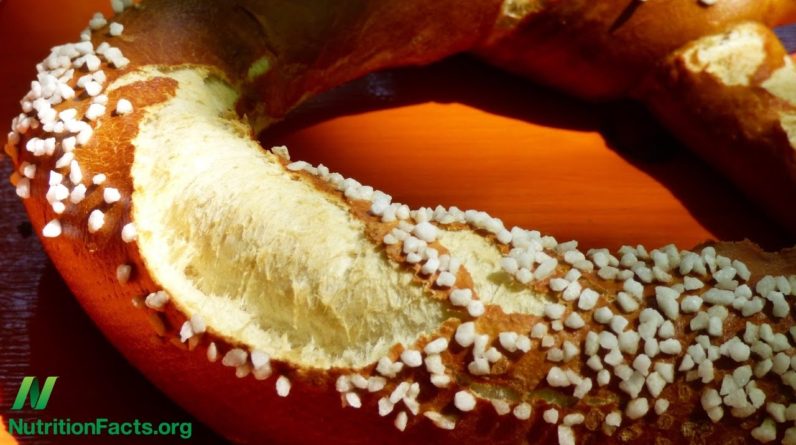
If you go to the store in search of milk, there are a dizzying number
of products to choose from. There’s dairy milk,
but also plant-based products. To turn a plant into something
resembling milk, it must be either soaked, drained,
rinsed, and milled into a thick paste, or dried, and milled into flour. The plant paste or flour is then
fortified with vitamins and minerals, flavoured, and diluted with water. The result is a barrage of options that share many of the qualities
of animal milk. So which milk is actually best for you? Let’s dive into some of the most
popular milks: dairy, almond, soy, or oat? A 250 ml glass of cow’s milk contains
8 grams of protein, 12 grams of carbohydrates,
and 2 to 8 grams of fat depending on if it’s skim,
reduced fat, or whole. That’s approximately 15%
the daily protein an average adult needs, roughly 10% the carbohydrates
and 2 to 15% the fat. Most plant-based milks have
less carbohydrates than dairy milk. They also have less fat, but more
of what’s often called “good fats.” Meanwhile, the healthy nutrients
vitamin D and calcium found in dairy milk don’t occur naturally
in most plant-based milks.
Looking more closely
at our plant-based milks, both almond and oat are low
in protein compared to dairy. But while almond milk has the least
nutrients of the four, oat milk is full of beta-glucans,
a healthy type of fibre. It also has a lot of carbohydrates
compared to other plant milks— sometimes as much as dairy milk. Soy milk, meanwhile,
has as much protein as cow’s milk and is also a great source
of potassium.
Soybeans contain isoflavone, which people used to think
might trigger hormonal imbalances by mimicking the function of estrogen. But ultimately, soy milk contains
very small amounts of isoflavones, which have a much weaker effect
on our bodies than estrogen. Depending on individual circumstances, one of these milks may be
the clear winner: if you’re lactose intolerant,
then the plant-based milks pull ahead, while if you’re allergic to nuts,
almond milk is out. For people who don’t have access
to a wide and varied diet, dairy milk can be the most efficient
way to get these nutrients.

But all else being equal,
any one of these four milks is nutritious enough to be part
of a balanced diet. That’s why for many people,
the milk that’s best for you is actually the milk
that’s best for the planet. So which uses the fewest resources
and produces the least pollution? It takes almost 4 square kilometers
to produce just one glass of cow’s milk, land use that drives deforestation
and habitat destruction. Most of that is land the cows live on,
and some is used to grow their feed. Many cows eat soy beans and oats. It takes much less land to grow
the oats or soybeans for milk than it does to feed a dairy cow— only about a quarter square kilometer
per glass.
Almond milk has similar land use. But where that land is also matters— soybean farms are a major driver
of deforestation, while oat and almond farms aren’t. Making milk uses water
every step of the way, but it’s the farming stage
where big differences emerge. Dairy milk uses the most water—
about 120 liters per glass, mostly to water cows
and grow their food. Almonds take second place, at more
than 70 liters of water per glass. Most of that water is used to grow
almond trees, which take years of watering before
they start producing almonds. The trees must be watered consistently,
or they die, while many other crops can be
left fallow and still produce later.
All told, soy and oats require less
water to grow: only about 5 to 10 liters
per glass of milk. Milk production generates some
greenhouse gas emissions— about 0.1 to 0.2 kilograms per glass
for the plant-based milks. But for dairy milk, the cows themselves
also produce emissions by burping and farting out large
quantities of the gas methane. Overall, each glass of dairy milk contributes over half a kilogram
of greenhouse gas emissions. So while depending on your dietary
needs, any one of these milks may be a good
fit, in terms of the health of our planet there’s a strong case for choosing
plant-based milks, particularly oat or soy milk..







